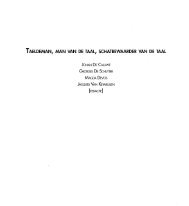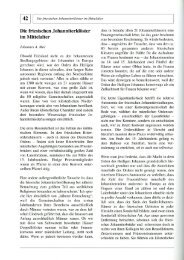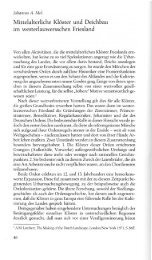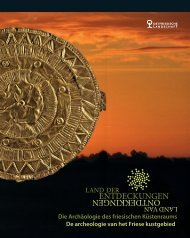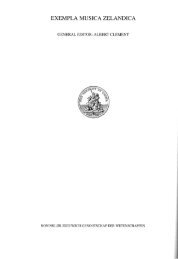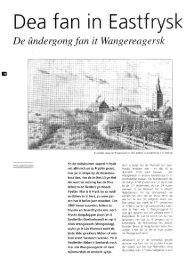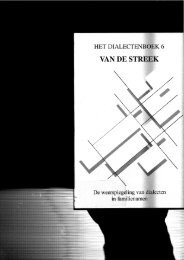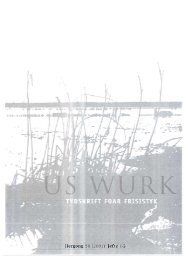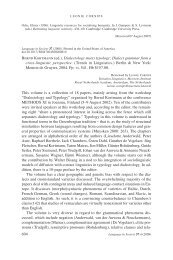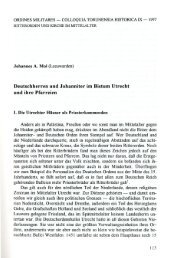Antropologen, historici en de hartslag van het archief
Antropologen, historici en de hartslag van het archief
Antropologen, historici en de hartslag van het archief
Create successful ePaper yourself
Turn your PDF publications into a flip-book with our unique Google optimized e-Paper software.
Wh<strong>en</strong> E<strong>van</strong>s-Pritchard retired in 1968, both Thomas and his stud<strong>en</strong>1;. Alan Macfarlane<br />
participated in the confer<strong>en</strong>ce held in the master's honour (Douglas 1971; see also Marwick<br />
1970; Macfarlane 1970).<br />
Sketched all too briefly, this is how the pas <strong>de</strong> <strong>de</strong>ux took off. This was the' <strong>en</strong>tree'; these<br />
were the 1960s. The first anthropological historians turned to anthropology for the<br />
transcontin<strong>en</strong>tal comparisons to be drawn, which <strong>en</strong>abled them to trace the broa<strong>de</strong>r social<br />
patterns in their docum<strong>en</strong>ts and thus successfully traverse the historical sub-disciplines.<br />
At pres<strong>en</strong>t, few cultural historians still draw such global analogies. Already in the 1970s,<br />
several American historians of witchcraft noted their objection that the African societies visited<br />
by anthropologists lacked the cultural complexity of early mo<strong>de</strong>m Europe. Ev<strong>en</strong> more important<br />
was an exchange in 1975 betwe<strong>en</strong> Thomas and anthropologist Hildred Geertz, who held that<br />
western categories such as witchcraft or magic could not simply be transferred to seemingly<br />
related cultural ph<strong>en</strong>om<strong>en</strong>a in other periods or in other contin<strong>en</strong>ts. She did not dismiss Thomas'<br />
book, nor did she say that historians and anthropologists should stop drawing ethnographic<br />
parallels. In keeping with the linguistic tum coming to the fore in anthropology, she only wished<br />
to argue that the conceptual or<strong>de</strong>r western thinking imposed on religion and magic was not likely<br />
to agree with the or<strong>de</strong>r implied in early mo<strong>de</strong>m or contemporary African thinking on the subject.<br />
Historians and anthropologists should take note of Saussurean linguistics (Geertz 1975; cf.<br />
Hutton 2004: 414-15).<br />
Though Geertz phrased her comm<strong>en</strong>ts carefully, the conclusions drawn by Thomas were<br />
nothing short of radical. He realised that with the linguistic tum ('the imm<strong>en</strong>se curr<strong>en</strong>t interest<br />
among anthropologists in linguistics, symbolism, and communications theory'), Geertz and<br />
many of her colleagues had grown 'chary about using the Western concept of "magic" tout<br />
court'. Accordingly, he proposed dropping the transcontin<strong>en</strong>tal but not the historical analogies.<br />
As anthropologist Edmund Leach already observed in 1961, 'English-language patterns of<br />
thought are not a necessary mo<strong>de</strong>l for the whole of human society'. Thomas agreed, up to a<br />
point: 'though unsuitable for export they may well be good <strong>en</strong>ough for home' (Leach 1961: 27;<br />
Thomas 1975: 94).<br />
The 1980s witnessed an explosion of witchcraft studies conc<strong>en</strong>trating on early mo<strong>de</strong>m<br />
Europe or the English colonies in America, which but with a few exceptions refrained from<br />
further global comparisons. The field <strong>de</strong>veloped its own issues and <strong>de</strong>bates, and found support in<br />
8<br />
another quickly expanding field, namely the history of popular culture (Burke 1978;<br />
Muchembled 1978). The Africanists withdrew as well. Largely id<strong>en</strong>tifying with the emerging<br />
postcolonial studies, they more or less forgot about the historians and their witchcraft studies. A<br />
<strong>de</strong>ca<strong>de</strong> later, though, some of them questioned the allegedly greater simplicity of African<br />
societies. Confronted with an int<strong>en</strong>sification rather than a dissipation of witch beliefs in the<br />
mo<strong>de</strong>rnising sub-Saharan nation-states, they wished to revisit the transcontin<strong>en</strong>tal analogies<br />
(Geschiere 1997: 188-223; cf. Hutton 2004: 416-18).<br />
Ironically, while anthropology's linguistic tum put an <strong>en</strong>d to the disciplines' converg<strong>en</strong>ce<br />
at a comparative level, it inspired a new and far more successful rapprochem<strong>en</strong>t at another,<br />
epistemological level. In the 1980s many cultural historians sought to buttress their historical<br />
imagination, not so much through cross-cultural analogies as through Clifford Geertz's analogy<br />
of the text, his symbolic anthropology. The pas <strong>de</strong> <strong>de</strong>ux continued: the '<strong>en</strong>tree' may have come<br />
to a halt, but the 'adagio' was beginning.<br />
The 'adagio'<br />
Let's start again with Keith Thomas, with his evolving i<strong>de</strong>as on what an anthropologically<br />
informed cultural history (or 'retrospective ethnography', as he likes to call it) should imply. As<br />
he observed in 1989: 'The cultural historian's task, like that of the cultural anthropologist, is thus<br />
to translate ali<strong>en</strong> cultures into our own terms. He has to make intelligible to mo<strong>de</strong>m rea<strong>de</strong>rs the<br />
rules and implicit assumptions of a <strong>van</strong>ished age'. Such a historian, he continued, has to learn<br />
both the spok<strong>en</strong> and the social language. More concretely, he must learn to approach society as a<br />
language in itself, to ext<strong>en</strong>d like the structuralists 'the linguistic analogy to society as a whole'.<br />
Cultures, th<strong>en</strong>, should be viewed as systems of signs and should be 'read' as such. Each object,<br />
practice or belief has its own position in the social system and <strong>de</strong>rives its specific meaning from<br />
its contrast with elem<strong>en</strong>ts elsewhere in the system. For example, cultural historians may contrast<br />
a garm<strong>en</strong>t like a top hat with a flat cloth cap or, to m<strong>en</strong>tion a favourite example of my own, a<br />
handshake (which, as our pres<strong>en</strong>t egalitarian gesture, only originated in the sev<strong>en</strong>te<strong>en</strong>th c<strong>en</strong>tury)<br />
with a bow or curtsy (Thomas 1991: 75; Rood<strong>en</strong>burg 1991).8 It all <strong>de</strong>p<strong>en</strong>ds on the wi<strong>de</strong>r<br />
symbolic field. To quote another cultural historian writing on the Fr<strong>en</strong>ch Revolution: 'The action<br />
8 The text relies on a lecture Thomas gave at a Dutch confer<strong>en</strong>ce on cultural history held in 1989.<br />
9



